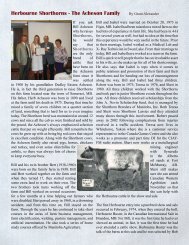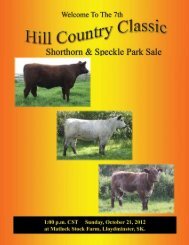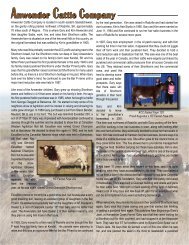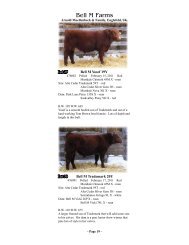The Thompson's of Poplar Park - Canadian Shorthorn Association
The Thompson's of Poplar Park - Canadian Shorthorn Association
The Thompson's of Poplar Park - Canadian Shorthorn Association
You also want an ePaper? Increase the reach of your titles
YUMPU automatically turns print PDFs into web optimized ePapers that Google loves.
<strong>The</strong> <strong>Thompson's</strong> <strong>of</strong> <strong>Poplar</strong> <strong>Park</strong><br />
By Grant Alexander<br />
A trip to Hamiota, Manitoba, to the farm <strong>of</strong> John and<br />
Susan Thompson and<br />
family is never a wasted day. It is quite the contrary, if you<br />
enjoy friendly people and good <strong>Shorthorn</strong><br />
cattle. <strong>The</strong>ir farm is situated about halfway between Virden<br />
and Riding Mountain National <strong>Park</strong> in west central<br />
Manitoba. It is mixed farming country with rich fertile<br />
soils. Contrary to much <strong>of</strong> Western Canada, this part <strong>of</strong><br />
Manitoba has received substantial amounts <strong>of</strong> rainfall<br />
this spring. Not too many miles from the Thompson<br />
farm, farmers were unable to plant their crops because<br />
<strong>of</strong> the wet conditions.<br />
<strong>The</strong> farm where John and Susan live was settled by<br />
John's grandfather, Corbett Brown, in 1907. He moved<br />
here from the family farm in the tobacco growing<br />
area <strong>of</strong> southern Ontario. His son Norman was born<br />
there and farmed there his entire lifetime. John was<br />
raised a mile and a half down the road, and from a<br />
very early age road his bicycle down to his uncle<br />
Norman's farm almost every weekend to help out. In<br />
1973, John bought his first <strong>Shorthorn</strong> cow, and in 1976 he<br />
started farming full time with Norman. John registered his<br />
cattle with the JT prefix while Norman continued to use<br />
the <strong>Poplar</strong> <strong>Park</strong> herd name.<br />
John and Susan were married in 1985, and their marriage<br />
has been blessed with four children, William, Sean,<br />
Russell and Evelyn. All four children are involved in the<br />
farming operation along with their parents, and are very<br />
active in 4-H. This year they have 16 head showing in<br />
their local 4-H show. John is in his first year <strong>of</strong> being the<br />
leader <strong>of</strong> their 4-H club and says he didn't realize how big<br />
a job this was.<br />
<strong>The</strong>ir farm consists <strong>of</strong> 1600 acres <strong>of</strong> which about 700<br />
acres is in cereal< crop production with the balance being<br />
pasture and hay land. John says that the crop acreage seems<br />
to decrease every year, as more and more is seeded to<br />
grass. <strong>Shorthorn</strong> cattle have been on this farm since it was<br />
homesteaded and the first registered females arrived in the<br />
1930's. <strong>The</strong> Browns showed their <strong>Shorthorn</strong>s extensively<br />
throughout Manitoba for<br />
several years. John remembers hearing about one <strong>of</strong> the<br />
bulls that provided the foundation for the herd. This bull<br />
was Ridgeview Peter Pan and he was Grand Champion bull<br />
at the 1949 Brandon Exhibition. This bull was purchased<br />
from the good Killoh herd, who were their neighbors, and<br />
he grew into a very big bull who bred extremely well for<br />
them. John says that even today he has older men who<br />
come to the farm to look at his bulls who recall this bull in<br />
their conversations, even though it was over 50 years ago.<br />
Two other bulls from Richardson Stock Farm, Winnipeg,<br />
as well as a bull from Searle Farms, Selkirk are other early<br />
sires that worked well in the herd. John remembers one <strong>of</strong><br />
the Richardson bulls, Kelburn Quicksilver, being tied in<br />
the barn for part <strong>of</strong> the winter. He was a big white bull and<br />
when he was supposed to look after feeding him, it was<br />
easier to go under him than around him, so that was how<br />
he got to the other side.<br />
<strong>The</strong> first registered females were purchased from Irwins<br />
at Newdale, Manitoba. <strong>The</strong>se females were polled and<br />
in those days there was a very limited market for polled<br />
cattle. Norman used to say that it took them years to breed<br />
the polled gene out <strong>of</strong> these females, and about the time<br />
they finally accomplished it, they had to start to try to<br />
breed it back into them. Today's herd is predominately<br />
polled however there are still many horned animals. John<br />
likes to use polled sires simply because polled bulls are<br />
easier to sell, however, he is quick to point out that some<br />
<strong>of</strong> the horned bulls they used did an excellent job for them.<br />
<strong>Poplar</strong> <strong>Park</strong> Mist 4R and <strong>Poplar</strong> <strong>Park</strong> Extender were two<br />
<strong>of</strong> these horned bulls and one has to agree when you see<br />
the daughters in the herd.<br />
<strong>The</strong> cow herd numbers have stayed relatively constant<br />
with around 130 breeding age females. With more being<br />
seeded to grass each year, there could be some expansion<br />
in the future. John says that they have always had good<br />
sized cows in the herd. He mentions a big cow who bred<br />
extremely well for them that came in from pasture open in<br />
the fall. His hired man had nicknamed her "the battleship"<br />
and since she was open, she went to market. She weighed<br />
over 2200 pounds at the auction mart. Today, the pastures
are full <strong>of</strong> big framed cows with thickness and volume.<br />
<strong>The</strong>y are also easy fleshing females and have big thick<br />
meaty calves on them.<br />
John's detail to structural soundness and no nonsense cattle<br />
comes from the years he spent with Norman. To Norman,<br />
structural soundness was extremely important. John<br />
remembers going with Norman to visit Colin Patterson<br />
at Yorkton, Saskatchewan on numerous occasions. He<br />
says Colin's good herd <strong>of</strong> <strong>Shorthorn</strong>s was really only an<br />
excuse as they always ended up spending hours analyzing<br />
the Clydesdale horses he kept. He says that if Colin and<br />
Norman heard <strong>of</strong> a horse that they hadn't seen, they<br />
could always find an excuse to go see it. John says this<br />
background was one <strong>of</strong> the main reasons that structural<br />
soundness was always so important. He says that he sees<br />
some younger cattle judges today that don't emphasis this<br />
same importance to structural soundness and as a result,<br />
some cattle are winning shows that these older breeders<br />
would have never used.<br />
One can not write about the <strong>Poplar</strong> <strong>Park</strong> herd without writing<br />
about Norman Brown. Norman was an astute cattleman,<br />
who knew what he wanted and was never influenced by<br />
trends and what others thought. He watched these trends<br />
though and when he saw animals that interested him, he<br />
was not afraid to use them. In 1975, Norman purchased<br />
a female from Doug Morris, Scotsmorr <strong>Shorthorn</strong>s,<br />
Saskatoon, Saskatchewan and she was carrying one <strong>of</strong> the<br />
first calves to be born by Highfield Irish Mist. John recalls<br />
the day this calf was born and how impressed Norman was<br />
with it. He says that Norman had semen ordered from Irish<br />
Mist by the time the calf was a few days old, even though<br />
the <strong>Canadian</strong> <strong>Shorthorn</strong> <strong>Association</strong> had not accepted the<br />
Irish cattle into the herdbook yet. John is quick to point out<br />
that virtually every female in today's herd carries at least 2<br />
crosses <strong>of</strong> Highfield Irish Mist, and there are several that<br />
have him 5 or 6 or more times in their extended pedigree.<br />
He says he is never concerned about this inbreeding, as it<br />
has never failed them. He says that this is one bloodline<br />
that seems to work better the more concentrated it gets in<br />
their herd.<br />
Norman Brown was a student <strong>of</strong> <strong>Shorthorn</strong> pedigrees, and<br />
was always watching new bloodlines that appeared. John<br />
recalls that Norman was impressed with the photos <strong>of</strong> some<br />
<strong>of</strong> the HS Rodeo Drive x* <strong>of</strong>fspring he saw in the American<br />
<strong>Shorthorn</strong> breed magazine "<strong>Shorthorn</strong> Country". In 1991,<br />
Huberdale Farms <strong>of</strong> Lipton, Sask-atchewan consigned a<br />
Rodeo Drive x* son in the Agribition sale. John says he<br />
fully expected that this bull, Huberdale Rival 5A x* would<br />
be coming back with Norman, even though he had never<br />
mentioned purchasing him. He recalls some breeders<br />
telling Norman that he probably was making a mistake,<br />
but he was determined to test him in their herd. <strong>The</strong> next<br />
spring Rival x* was turned out with a true sampling <strong>of</strong> the<br />
herd and the calves proved to be excellent. Rival was used<br />
for several years and many sons were sold to commercial<br />
producers. Several daughters remain in the herd today.<br />
John says that they have used some appendix bloodlines<br />
in their herd and have many animals that are registered in<br />
each the closed and the appendix herdbooks. He says he<br />
judges cattle on their individual merit rather than which<br />
herdbook they are in. A bigger concern to him is birth<br />
weights, and he feels that <strong>Shorthorn</strong> breeders have to be<br />
very conscious <strong>of</strong> this if we are going to gain a bigger share<br />
<strong>of</strong> the commercial bull market. He says it is <strong>of</strong>ten difficult<br />
to keep the birth weights at acceptable levels, especially<br />
from some <strong>of</strong> their biggest cows, but it is important and<br />
he is always trying to use bulls that will produce moderate<br />
birth weight calves.<br />
Over the years, they have used artificial insemination in<br />
the herd to introduce new bloodlines. <strong>The</strong>y also use A.I.<br />
to reintroduce some <strong>of</strong> the genetics from some <strong>of</strong> their<br />
former herd sires that bred well for them. John says they<br />
also have used embryo transplant on their best cows and<br />
still has embryos in<br />
storage from some <strong>of</strong> the great females that are now gone.<br />
He says he intends to use these embryos to bring back<br />
these genetics that worked so well for them in future<br />
years. <strong>The</strong>y have used numerous bulls through A.I. and<br />
have <strong>of</strong>ten used some <strong>of</strong> the best A.I sired bulls in their<br />
herd. John says that he has never been afraid to use home<br />
bred bulls as some <strong>of</strong> the greatest bulls they have ever<br />
used have been ones they raised. Two <strong>of</strong> their present herd<br />
sires are home bred bulls, and when you see the calves, it<br />
is easy to see what he is saying.<br />
John is a real believer in retaining cow family names on<br />
his females. <strong>The</strong> majority <strong>of</strong> the herd stem from some <strong>of</strong><br />
the cow families they have found to be superior breeding<br />
lines in their herd. <strong>The</strong> Betsy's and the Madge Heroine's<br />
originated from two females they purchased in one <strong>of</strong> the<br />
Golden Harvest Sales in Saskatoon in the 70's. <strong>The</strong>y were<br />
Scotsmorr Roan Betsy x and Gemvale Madge Heroine x.<br />
<strong>The</strong> Florence family originated from a Florence female<br />
purchased from their neighbor, Jack Wright's Colehill herd.<br />
<strong>The</strong> Muffin's originated from another Scotsmorr female<br />
that was straight Four Point breeding from the good Elmer<br />
Berg herd in Alberta. <strong>The</strong> Kate family goes back to the full<br />
Irish female, Highfield Kate 3rd. John recalls purchasing<br />
a female a few years ago that the breeder had changed<br />
the cow family name on. He says that they promptly had<br />
her name changed back to the original cow family once
they had the registration paper sent to them. John says that<br />
new female lines are added to the herd from time to time,<br />
however, they have to compete with their other cows to<br />
gain the right to stay there. <strong>The</strong>y have to produce or they<br />
go down the road.<br />
When asked about some <strong>of</strong> the sires that have worked well<br />
in the herd since he became involved, John lists <strong>of</strong>f several<br />
names. When you look at the list, you can see that they have<br />
been blessed with some excellent breeding bulls. Kenmar<br />
Ranger 74K x was the first bull he mentions and he says<br />
that this bull sired excellent calves <strong>of</strong> both sexes. He was<br />
a son <strong>of</strong> Four Point Ranger x and was purchased from the<br />
herd <strong>of</strong> Harvey Fulton and Sons, Birtle, Manitoba. A son,<br />
<strong>Poplar</strong> <strong>Park</strong> Ranger 36N x was kept and he also worked<br />
well. This bull was Reserve Grand Champion at the 1984<br />
Royal Winter Fair in Toronto, as well as Junior Champion<br />
at Agribition the same year.<br />
Gemvale Ivor Pacesetter x was purchased on the phone,<br />
from a Golden Harvest Sale, as they were busy harvesting.<br />
He was a 3/4 Irish bull sired by Sandy Creek Ivor and from<br />
an Irish Mist dam. John remembers that they wondered<br />
what they had done when the bull arrived, however, they<br />
used him and he turned into a tremendous breeding bull for<br />
them. His genetics can still be found in the backgrounds<br />
<strong>of</strong> many <strong>of</strong> the best females.<br />
<strong>Poplar</strong> <strong>Park</strong> Mist 4R came along next and this bull was a<br />
product <strong>of</strong> breeding Scotsmorr Roan Betsy x to Highfield<br />
Irish Mist. Mist 4R was a very impressive bull who bred<br />
extremely well and left many excellent sons and daughters.<br />
<strong>The</strong>re were many excellent herd sires produced from this<br />
bull including <strong>Poplar</strong> <strong>Park</strong> Western Mist x, who sold to<br />
Charlie Campbell, Lumsden, Saskatchewan, and who<br />
was Grand Champion Bull at Agribition after breeding 80<br />
cows as a yearling. John still has semen from 4R and goes<br />
back to it from time to time to reintroduce the bloodline in<br />
his herd. JT Titan x was a son <strong>of</strong> Mist 4R who had a great<br />
show career and an<br />
interest was sold to Glenford <strong>Shorthorn</strong>s, Neudorf,<br />
Saskatchewan. Titan grew into a massive easy fleshing<br />
bull and his influence is still evident in the herd today.<br />
<strong>Poplar</strong> <strong>Park</strong> Extender, a son <strong>of</strong> Titan x, was retained and<br />
this bull is still considered by many breeders to be one<br />
<strong>of</strong> the best <strong>Shorthorn</strong> bulls they ever saw. Not only did<br />
Extender have a great pr<strong>of</strong>ile, but he was a great breeding<br />
bull and the herd still has some wonderful daughters. John<br />
remembers taking Titan x and Extender to a Beef Field<br />
Day to display them. While there, the bulls were weighed.<br />
Titan x weighed over 3000 lbs. and Extender, his son,<br />
was well over 2800 lbs. Huberdale Rival 5A x followed<br />
along with a home bred son <strong>of</strong> HS Instant Enticer x called<br />
<strong>Poplar</strong> <strong>Park</strong> Elite x. Both these bulls worked well in the<br />
herd. In more recent years, two bulls were purchased from<br />
the herd <strong>of</strong> Lorne Carter, Spy Hill, Saskatchewan. Flying<br />
C Manitoba Red x was sired by a <strong>Poplar</strong> <strong>Park</strong> bull who<br />
was a Seven T's Greg x son out <strong>of</strong> their good Florence<br />
5W female, who also was the dam <strong>of</strong> JT Titan x. Flying<br />
C Foundation x was sired by JT Challenger x, a son <strong>of</strong><br />
the Australian Moombi Powerplay x and Florence x.<br />
Another Powerplay son, JT Powerplay 26E was also used<br />
with excellent success. <strong>The</strong>re are many daughters <strong>of</strong> these<br />
bulls in the herd today and they are pro<strong>of</strong> that these sires<br />
produced the right kind. Present herd sires include JT Jeff<br />
44J x, a son <strong>of</strong> Homedale Flash x and a Spry's Cyclone x<br />
dam, and Kenmar Thunder 75Jx.<br />
<strong>The</strong> <strong>Thompson's</strong> have been able to develop a good bull<br />
trade and annually send bulls to the Douglas Test Station<br />
and more recently to the Gunton Test station. Most <strong>of</strong> their<br />
bulls sell out <strong>of</strong> the yard by private treaty. <strong>The</strong>y have also<br />
been very active in Manitoba <strong>Shorthorn</strong> <strong>Association</strong> events<br />
and have supported shows and sales throughout Canada.<br />
For many years they have shown and sold at <strong>Canadian</strong><br />
Western Agribition in Regina. Susan recalls the story <strong>of</strong><br />
the year their first child, William, was born. John had sent<br />
the show cattle to Regina and had stayed home because<br />
the baby was due. William arrived just after 2 a.m. the<br />
morning <strong>of</strong> the show, and she said John thought he could<br />
still make the 8 a.m. show if he left right away and drove<br />
straight through. She says John missed that show, and<br />
one gets the impression that there may have been a more<br />
noticeable gap in ages between their first child and the<br />
next three, if he had gone.<br />
On January 12, 1998, Norman Brown passed away<br />
suddenly <strong>of</strong> a heart attack at the age <strong>of</strong> 80 years. He had<br />
remained active on the farm until the day <strong>of</strong> his death.<br />
John says that other than having his appendix removed at<br />
age 8, he had never spent another day in a hospital. You<br />
can tell that he is still missed by the family, however John<br />
says he probably went just the way he would have wanted<br />
to. Norman left a legacy <strong>of</strong> knowledge and integrity that<br />
won't soon be forgotten.<br />
If you visit the Thompson farm, you won't find an<br />
elaborate, expensive set <strong>of</strong> facilities. You will find a very<br />
practical operation. You will also find a set <strong>of</strong> <strong>Shorthorn</strong><br />
cattle that you won't soon forget. You will find a family<br />
that works together and has fun together. You will find a<br />
friendly warm family that welcomes you into their home.<br />
You will find interest and enthusiasm about <strong>Shorthorn</strong><br />
cattle from the oldest to the youngest family member. You<br />
will leave the farm feeling good and knowing that you<br />
would like to go back again.







